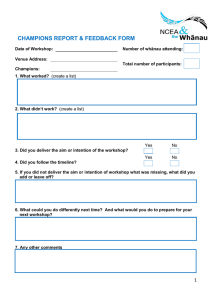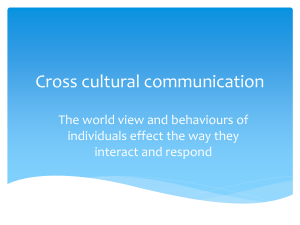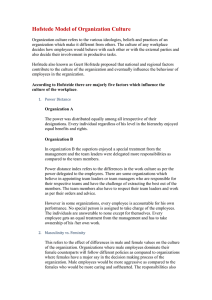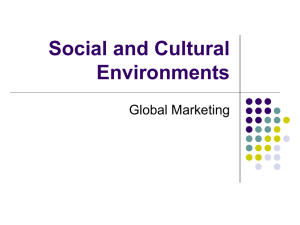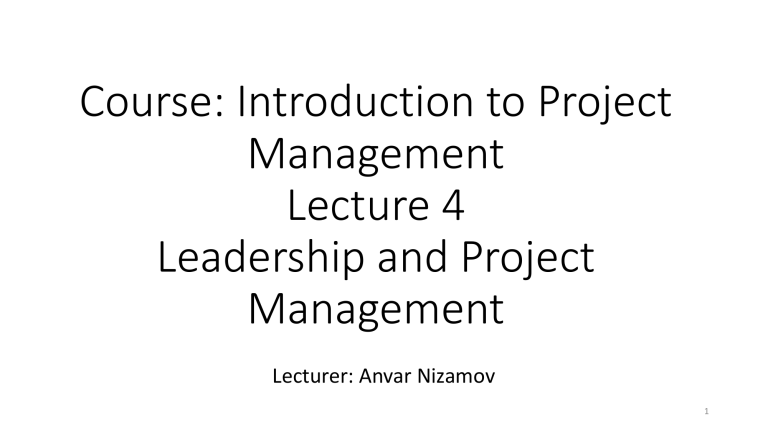
Course: Introduction to Project Management Lecture 4 Leadership and Project Management Lecturer: Anvar Nizamov 1 Chapter 4 Learning Objectives After completing this chapter, students will be able to: 1.Understand how project management is a “leader-intensive” profession. 2.Distinguish between the role of a manager and the characteristics of a leader. 3.Understand the concept of emotional intelligence as it relates to how project managers lead. 4.Recognize traits that are strongly linked to effective project leadership. Chapter 4 Learning Objectives After completing this chapter, students will be able to: 5. Identify the key roles project champions play in project success. 6. Recognize the principles that typify the new project leadership. 7. Understand the development of project management professionalism in the discipline. 8. Understand cross-cultural differences Leadership “The ability to inspire confidence and support among the people who are needed to achieve organizational goals.” Project management is leader intensive! Differences Between Managers and Leaders How the Project Manager Leads Project managers function as mini-CEOs and manage both “hard” technical details and “soft” people issues. Project managers: acquire project resources motivate and build teams have a vision and fight fires communicate Acquiring Resources Project are under funded for a variety of reasons: vague goals lack of top management support requirements understated insufficient funds distrust between managers 8 Expectancy, Instrumentality, and Valence 9 Herzberg’s Motivation-Hygiene Theory • Herzberg’s Motivation-Hygiene Theory • A need theory that distinguishes between motivator needs (related to the nature of the work itself) and hygiene needs (related to the physical and psychological context in which the work is performed) and proposes that motivator needs must be met for motivation and job satisfaction to be high. 10 McClelland’s Needs for Achievement, Affiliation, and Power • Need for Achievement • A strong desire to perform challenging tasks well and meet personal standards for excellence • Need for Affiliation • Extent to which an individual is concerned about establishing and maintaining good interpersonal relations, being liked, and having the people around him get along with each other • Need for Power • Extent to which an individual desires to control or influence others 11 Equity Theory • Equity Theory • A theory of motivation that focuses on people’s perceptions of the fairness of their work outcomes relative to their work inputs. • Equity • Justice, impartiality, and fairness to which all organizational members are entitled • Inequity • Lack of fairness 12 Equity Theory 13 Process of communication 14 Communication It is critical for a project manager to maintain strong contact with all stakeholders. Project meetings feature task-oriented and group maintenance behaviors. Communication Information richness 17 Characteristics of an effective project manager Characteristics of project managers who are not leaders Leadership & Emotional Intelligence Emotional intelligence - ability to understand that effective leadership is part of the emotional and relational transaction between subordinates and themselves. Five elements characterize emotional intelligence: • Self-awareness - deep understanding of one’s own strengths and weaknesses, ego needs, drives, and motives. • Self-regulation - the ability to reflect on events, respond to them after careful consideration, and avoid the mistake of indulging in impulsive behavior • Motivation - concrete or clear markers that demonstrate progress and consistent strive for greater and greater challenges. • Empathy - willingness to consider other team members’ feelings in the process of making an informed decision • Social skills - ability to manage relationships with others (it is friendliness with a purpose) Traits of Effective Project Leaders • Effective project managers must be good communicators. • Project leaders must possess the flexibility to respond to uncertain or ambiguous situations with a minimum of stress. • Strong project leaders work well with and through their project team. • Good project leaders are skilled at various influence tactics. What are Project Champions? Champions are “fanatics” in the single-minded pursuit of their pet ideas. Champions can be: • creative originator • entrepreneur • “godfather” or sponsor • project manager Champion Roles Traditional Duties technical understanding leadership coordination & control obtaining resources administrative Nontraditional Duties • cheerleader • visionary • politician • risk taker • ambassador Creating Project Champions Identify and encourage their emergence. Encourage and reward risk takers. Remember the emotional connection. Free champions from traditional project management duties. New Project Leadership Four competencies determine a project leader’s success: 1. Understand and practice the power of appreciation. 2. Remind people what’s important. 3. Generate and sustain trust. 4. Align with the leader. Project Management Professionalism Project work is becoming the standard for many organizations. There is a critical need to upgrade the skills of current project workers. Project managers and support personnel need dedicated career paths. Creating Project Managers Match personalities with project work. Formalize commitment to project work with training programs. Develop a unique reward system. Identify a distinct career path. Right management choices in international setting 1. 2. 3. 4. 5. Develop a detailed understanding of the environment. Do not stereotype. Be genuinely interested in cultural differences. Do not assume there is one way (yours) to communicate. Listen actively and empathetically. The Role of National Culture • National culture • The set of values, norms, knowledge, beliefs, and other practices that unite the citizens of a country. • Values • Ideas about what a society believes to be good, desirable and beautiful. • Provides conceptual support for democracy, truth, appropriate roles for men, and women. • Usually not static but very slow to change. Sociocultural Forces (cont’d) • Norms • Unwritten rules and codes of conduct that prescribe how people should act in particular situations. • Folkways—routine social conventions of daily life (e.g., dress codes and social manners). • Mores—behavioral norms that are considered central to functioning of society and much more significant than folkways (e.g., theft and adultery), and they are often enacted into law. • Norms vary from country to country. Hofstede’s Model of National Culture Figure 4.4 Hofstede’s Model of National Culture • Individualism • A worldview that values individual freedom and self-expression and holds a strong belief in personal rights and the need for persons to be judged by their achievements rather their social background. • Collectivism • A worldview that values subordination of the individual to the goals of the group. • Widespread under communism and prevalent in Japan as well. • https://www.youtube.com/watch?v=78haKZhEqcg Hofstede’s Model of National Culture (cont’d) • Power Distance • A society’s acceptance of differences in the well being of citizens due to differences in heritage, and physical and intellectual capabilities (individualism). • In high power distance societies, the gap between rich and poor becomes very wide (e.g., Panama and Malaysia). • In the low power distance societies of western cultures (e.g., United States and Germany), the gap between rich and poor is reduced by taxation and welfare programs. Hofstede’s Model of National Culture (cont’d) • Achievement versus Nurturing Orientation • Achievement-oriented societies value assertiveness, performance, and success and are results-oriented. • Nurturing-oriented cultures value quality of life, personal relationships, and service. • The United States and Japan are achievement-oriented; Sweden and Denmark are more nurturing-oriented. Hofstede’s Model of National Culture (cont’d) • Uncertainty Avoidance • Societies and people differ in their tolerance for uncertainty and risk. • Low uncertainty avoidance cultures (e.g., U.S. and Hong Kong) value diversity and tolerate a wide range of opinions and beliefs. • High uncertainty avoidance societies (e.g., Japan and France) are more rigid and expect high conformity in their citizens’ beliefs and norms of behavior. Hofstede’s Model of National Culture (cont’d) • Long Term Outlook • Cultures (e.g., Taiwan and Hong Kong) with a long-term in outlook are based on the values of saving, and persistence. • Short-term outlook societies (e.g., France and the United States) seek the maintenance of personal stability or happiness in the present. Summary 1. Understand how project management is a “leader intensive” profession. 2. Distinguish between the role of a manager and the characteristics of a leader. 3. Understand the concept of emotional intelligence as it relates to how project managers lead. 4. Recognize traits that are strongly linked to effective project leadership. Summary 5. Identify the key roles project champions play in project success. 6. Recognize the principles that typify the new project leadership. 7. Understand the development of project management professionalism in the discipline.
